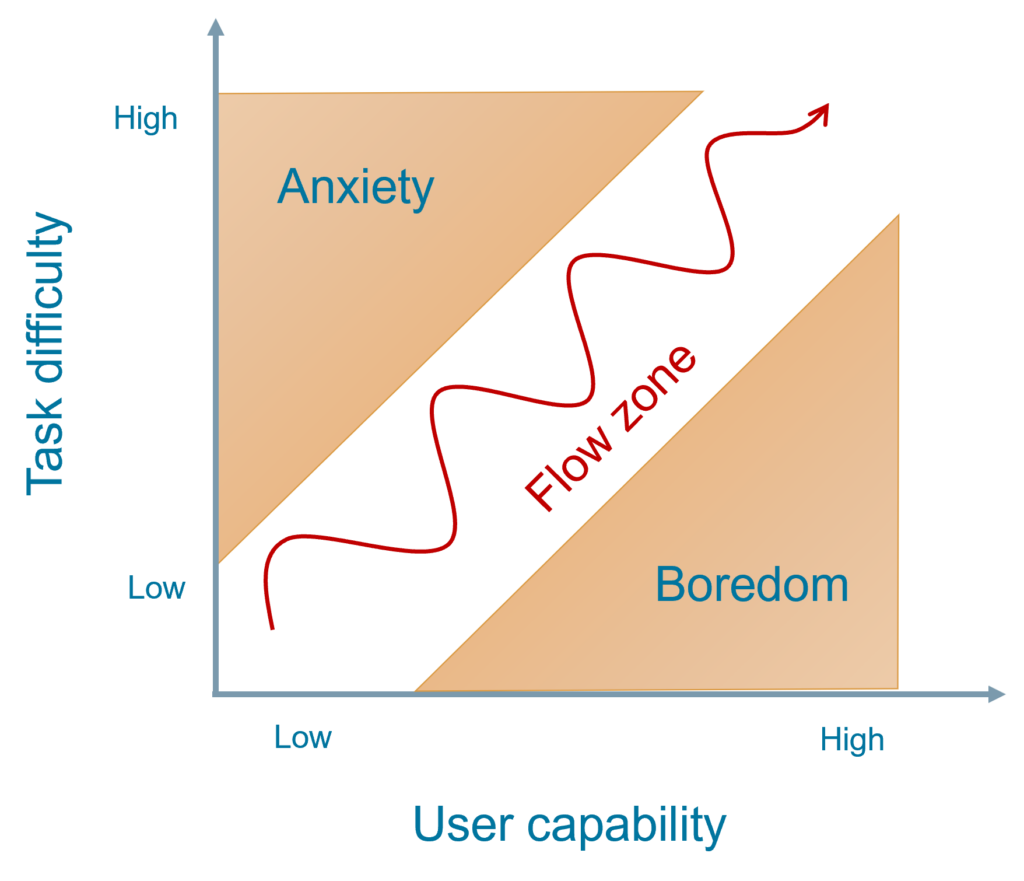5. Flow

Why it matters
Flow – It is that gratifying experience of uninterrupted deep focus. When you are completely immersed in what you do, you lose the sense of time. You are in flow when you get that exhilarating rush and a sense of fulfillment when you realize you are on the path of unraveling the mystery to a difficult problem. Some call it being “in the zone”.
When you are in flow, you are having a good time, you release energy. It’s a place where you want to be.
The million dollar question is: How do you get there?
How it works
From a leader position: My mission is to help my teams get in the best conditions to be in flow. This is where I want my teams to be.
Practice – Strike the right balance between skills and challenge
To get there, I need to strike the right balance between the teams’ skills, the teams’ level of self-confidence and find an inspiring challenge.

The challenge needs to be a little bit outside the comfort zone, exhilarating while mentally within the bounds of the achievable. Finding this balance requires some experimentation. You also need a good understanding of the people you are working with, and knowing their history would definitely help. Some are super adventurous, some are not. A team might never have had a fighting chance of achieving a goal because of variables outside their control. In which case, the bar should be set lower early on, to build trust and an early win, so the team can build self-confidence – “we can do this”.
Practice: Be explicit about the objective of keeping the team in a state of flow
It really is as simple as it sounds. Be explicit and share your long term objective with the team that flow is the state you want to be in. Organizations are often geared towards performance, it is the disease of the 20th century. We work too much! One clue to find out if an organization is geared towards performance is to look at the language used within the organization. The totally wrong thing to do when in a state of anxiety (see Figure 1 above) is to add more Pressure. This exacerbates the situation.
Being explicit about the long term goal of being in flow under these conditions is an act of leadership. When you move from words to action, motivation will grow. You are saying, “this is not a hopeless situation. We will find a way out!”
Practice: Resolving “too much pressure”
If your team is under too much pressure, there are still things we can do. Often a team in this state is not conscious of its own progress. There’s always the next thing to get busy with. If so, don’t be so hard on yourselves. Take stock of what you have accomplished. Acknowledge, and make the team members feel good about the hard work done. Allow the team to breathe by injecting retrospectives on a cadence.
Lower the ambitions the team has set, make the goal line-achievable . Set small goals, celebrate the small successes, the small wins. Feel good about it. It does wonders to morale and paves the way for the team to get in flow.
Practice: Act before your team gets bored
It’s easy to see that if the team stays in the anxiety zone too long (see Figure 1), this creates unhealthy stress.
What does not get talked about that often is that the reverse – a long term state of boredom, can also be harmful. (Note: Don’t confuse this with being able to recover from intense periods every now and then)
This can happen for example when people have been in the same situation for too long without any challenges. If team members are bored for long periods, they will also feel overlooked and become demotivated. They will start to pursue interesting stuff outside of work or ultimately leave. The best people often leave first – this is often the start of a downward spiral.
This is in stark contrast to being in a state of flow where the company wants more of you!
Practice: How do you know if your team is in flow?
There are a few cues you can look for. You know your team is in flow when they stick with the challenge long enough until they conquer it. With concentration and focus, the team explores new angles until it finds one that works, cheering on experimentation, while relentlessly focusing on the variables they can control instead of getting distracted by the ones they can’t. There is a sense of progress.
Other cues can be found in the team’s communication pattern. Members share useful information and feedback. There’s positive reinforcement between members, and humor!
Practice: You need to have it aimed
Being in a state of flow has a lot of similarities with play. Who is best at play? Kids! We can learn a lot from observing kids immersed in play. What makes them stay in the bubble for so long? Forgetting about food, getting cold, parents calling… Grown-ups fall out of this bubble quicker. Having flow aimed means building intrinsic motivation. When we succeed, we have our own strong self-motivation to stay in the flow zone longer.
Practice: Knowing when to move the bar
We develop all the time, so the bar should move with us. Knowing when to move the bar is an art form that develops over time. As with many other things, the only way to learn when is the right time and what is the right level of challenge is to experiment.
While being in flow is the long term game, true happiness is more like a glimpse. Learn to hunt for, and cherish those small sparks.
References
Csikszentmihalyi M (1997). Finding Flow: The Psychology of Engagement with Everyday Life (1st ed.). New York: Basic Books.
Flow – Psychology Today